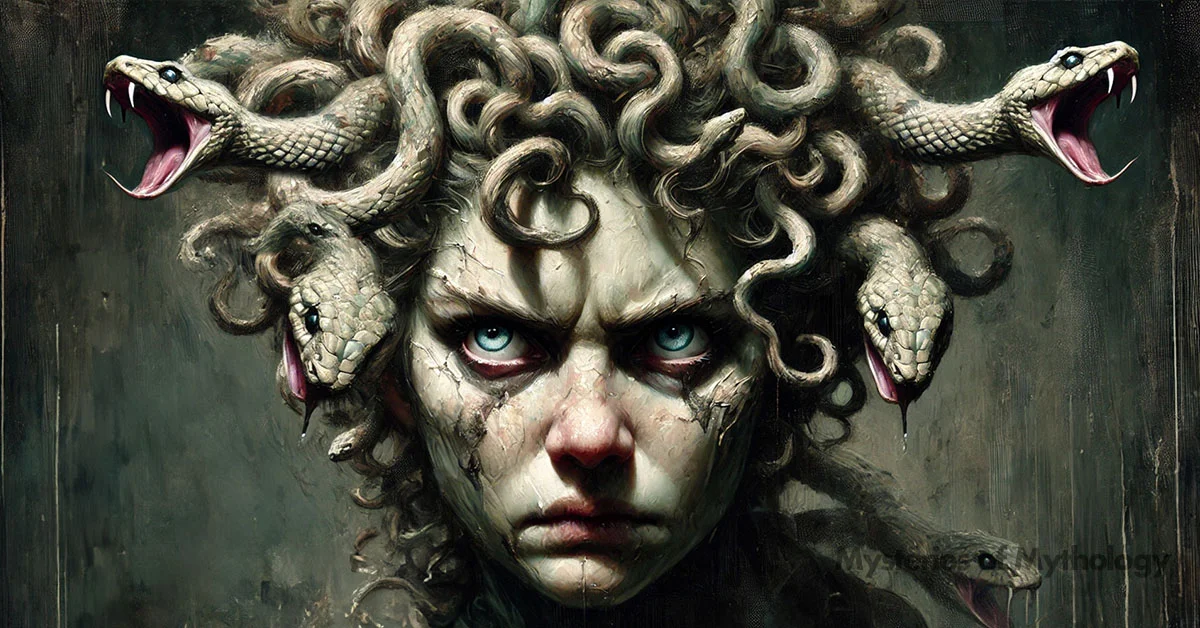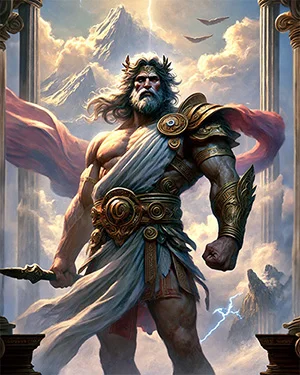Overview
Medusa was one of the three Gorgon sisters, daughters of the sea gods Phorcys and Ceto. Almost everyone has heard of the snake-haired monster from Greek mythology, but only a few know about the different variations of her creation.
Some versions portray her as being born as a beast, the only one of her sisters, Euryale and Stheno, who had a beautiful face. Other versions portray her as a once-human maiden, a victim of Poseidon’s advances and Athena’s fury. She was most famous for her stare that could turn any living creature to stone, and eventually, Perseus killed her and used her severed head as a weapon before giving it to Athena.
Want to know more? Read on…
Watch the related video
Etymology
The name “Medusa” comes from the ancient Greek word “Μέδουσα” (Médousa), which literally translates to “guardian” or “protectress.” This name hints she wasn’t just seen as a monstrous figure but also as a powerful being with a protective nature. We can see the root ‘med-’ “take appropriate measures” in names such as Diomedes, Medea, and Medon.
Pronunciation
ENGLISH
Medusa
GREEK
Μέδουσα
PHONETIC
[muh-DOO-suh]
IPA
/mɪˈdjuːsə/
Attributes
Medusa’s appearance was as well known as it was fearsome. She had live snakes for hair, and her gaze could turn anyone who looked directly at her into stone. Her face was often depicted with large, terrifying eyes and a wide, menacing mouth, and she was sometimes portrayed with fangs. This frightening image made her a symbol of both danger and protection against evil.
Despite her monstrous traits, some ancient poets, like Pindar, noted her former beauty, describing her as “fair-cheeked.” Being both beautiful and terrifying, this duality was a key part of her story.
In ancient art, Medusa was initially portrayed as a monstrous figure with wings, fangs, and a horrifying expression. Images of her head were often used as apotropaic symbols, symbols that had the power to avert evil. By the fifth century BCE, artists began to depict her with more human and beautiful features.

Of the three Gorgon sisters (Gorgos meaning “terrible or “fierce”), only Medusa was said to be mortal. This was why Perseus was sent to behead Medusa specifically.
According to ancient sources, the Gorgons were believed to live in various remote locations. Hesiod placed them near the Hesperides, in the far west, possibly near North Africa. Later authors like Herodotus and Ovid identified Libya as their homeland, linking them to the western edge of the known world.
Aeschylus mentioned the “Gorgonean plains of Cisthene” in the east, while other traditions placed them on the island of Sarpedon, possibly in Thrace or Anatolia. Some myths even associated the Gorgons with the Underworld, highlighting their connection to death and danger.
In some depictions, she has a woman’s body, but there are versions where she has the body of a serpent.
Family
Medusa came from a family of powerful mythological beings. She was the daughter of Phorcys and Ceto, ancient sea gods associated with the dangers of the ocean. Medusa had two sisters, Stheno and Euryale, who, unlike her, were immortal. Together, they are known as the Gorgons, fearsome creatures.
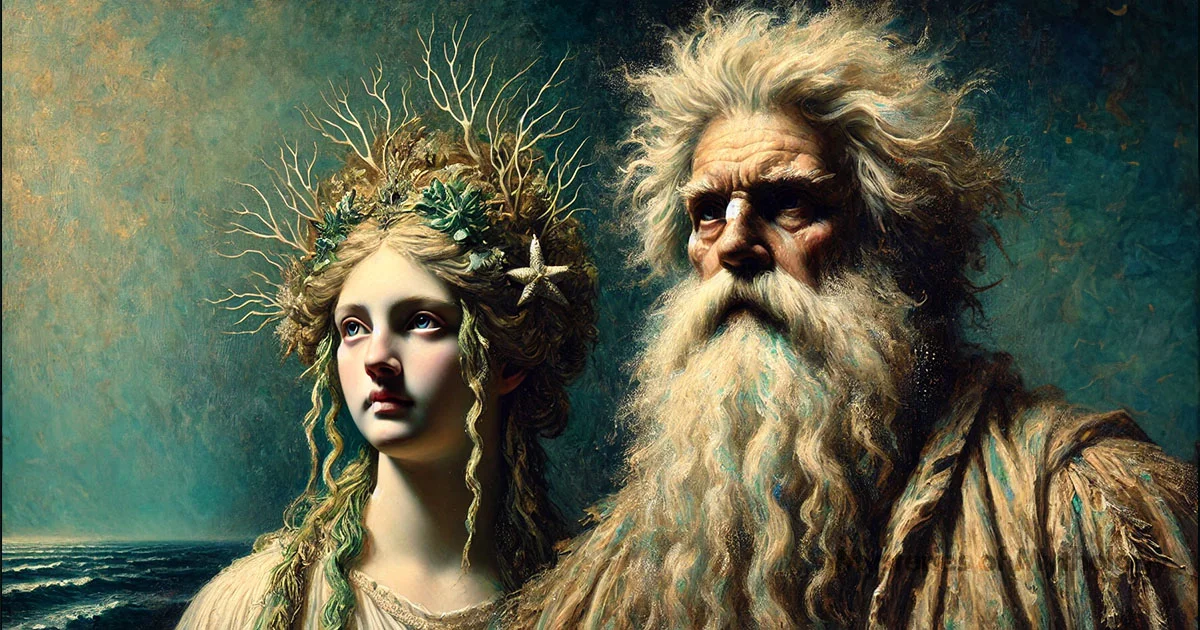
Family Tree
Parents
Father
Phorcys
Mother
Ceto
Siblings
brother
Ladon (a dragon)
Sisters
Stheno and Euryale (The Gorgons), Deino, Enyo, and Pemphredo known as The Graeae (The Grey Sisters),
Echidna
Consort
Lover
Poseidon
Children
Sons
Pegasus and Chrysaor (Born from her blood after her death)
Mythology
Medusa’s Origins
In earlier versions, such as Hesiod’s Theogony around the 8th century BCE, Medusa was described as one of three Gorgon sisters, along with Stheno and Euryale.
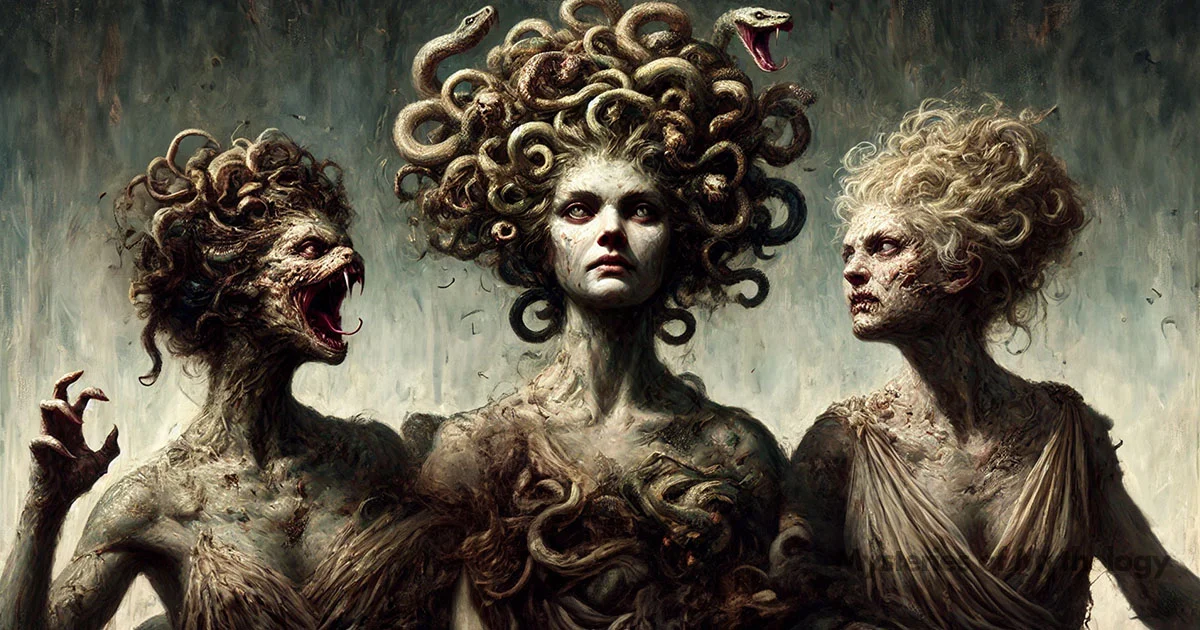
Her parents were the primordial gods Phorcys and Ceto, ancient sea gods predating Olympians like Zeus and Poseidon. In Hesiod’s version, little is said about Medusa other than that she was a monster and that Perseus beheaded her and used her petrifying stare as a weapon in his adventures.
She is also shown as having a mutual relationship with Poseidon, describing it as: “with her [Medusa] lay the Dark-haired one in a soft meadow among spring flowers”. This version is very different from the Roman poet, Ovid’s version of their relationship (see below). Interestingly, in this version, there is no description of Medusa having hair of snakes.
In the Roman poet Ovid’s Metamorphoses, we get a far more detailed version of Medusa. In this version, Medusa was originally a beautiful human maiden serving as a priestess in Athena’s temple. As a priestess, she had taken a vow of chastity and devoted her life to Athena.
Medusa was said to have beautiful, long locks of hair. Her beauty caught the attention of Poseidon, who approached Medusa at Athena’s temple. In some versions, they made love, and it was consensual. In other versions, Poseidon forced himself on Medusa. This union left Medusa pregnant.
Medusa once had charms; to gain her love
A rival crowd of envious lovers strove.
They, who have seen her, own, they ne’er did trace
More moving features in a sweeter face.
Yet above all, her length of hair, they own,
In golden ringlets wav’d, and graceful shone.– Ovid, Metamorphoses
In both versions, Athena was furious that her temple had been defiled, and turned Medusa into a monster. She transformed Medusa’s beautiful hair into poisonous snakes and cursed her with a gaze that would turn anyone unfortunate to look upon her into stone.
This transformation marks the turning point in her story, as Medusa goes from being a victim to becoming one of the most feared creatures in all of Greek mythology. As a Roman, Ovid wasn’t afraid to cast the Gods in a more negative light and often did so in his versions of the stories.
Medusa and Perseus
Perseus was the famous hero son of Zeus and the mortal princess Danae. If you’ve seen the film Clash of the Titans, this is the story’s hero. Perseus was given a seemingly impossible task by King Polydectes of Seriphos. The king, hoping to permanently get rid of Perseus so he could marry his mother, commanded him to bring back the head of Medusa, the only mortal Gorgon whose gaze could turn anyone to stone. King Polydectes thought Perseus would perish on his quest, leaving him free to be with Princess Danae.
Recognising the danger, the gods intervened. Athena provided a mirrored shield, Hermes gave winged sandals, Hades lent his helmet of invisibility, and Hephaestus offered a special sword. Armed with these gifts, Perseus set out on his perilous journey. After finding the Gorgons’ location from the Graeae, three sisters who shared a single eye, he ventured to the far reaches of the earth, where Medusa and her sisters lived.
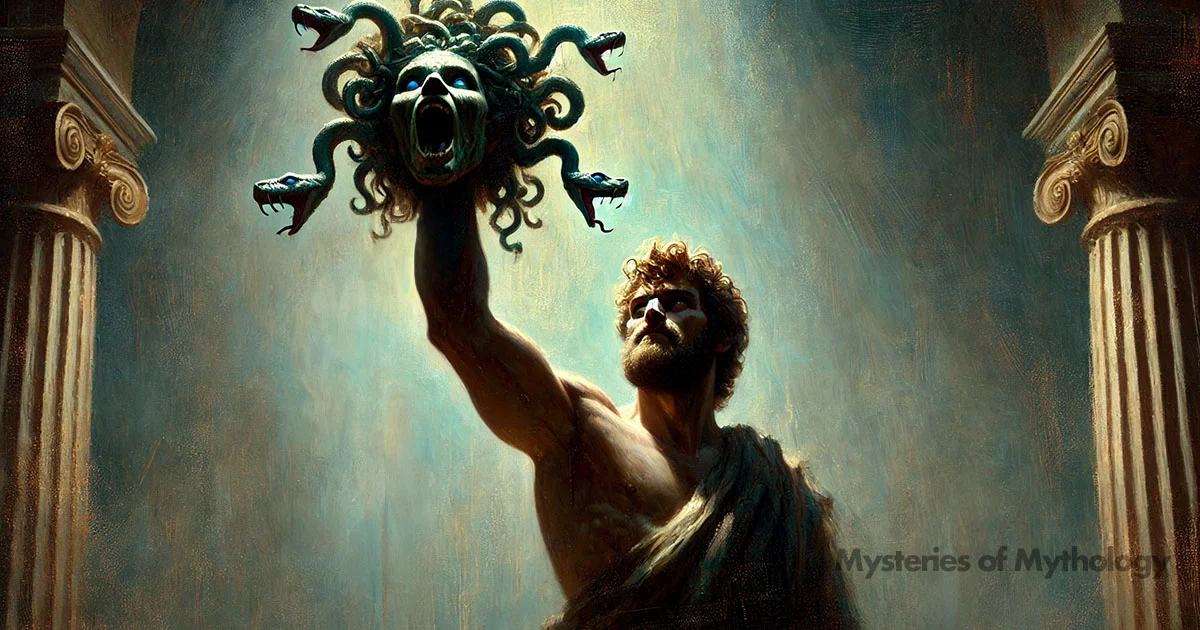
Perseus found Medusa asleep in her lair. Using the mirrored shield to avoid her petrifying gaze, he approached her and beheaded her with a swift stroke of his sword. Medusa’s sisters were also in the lair but could not capture Perseus as he wore the invisibility helmet. The Gorgon sisters returned to their secluded home to mourn Medusa’s loss. According to the ancient poet Pindar, Athena was deeply moved by their sorrowful lament. Inspired by their grief, she crafted the mournful instrument, the aulos, a double-reed pipe, to echo their sorrowful cries, “with instruments the echoing wail that was forced from the gnashing jaws of Euryale.”
From the blood that fell from Medusa’s neck sprang Pegasus, the famous winged horse (and my site’s logo), and Chrysaor, a giant wielding a golden sword. Both were considered children of Poseidon.
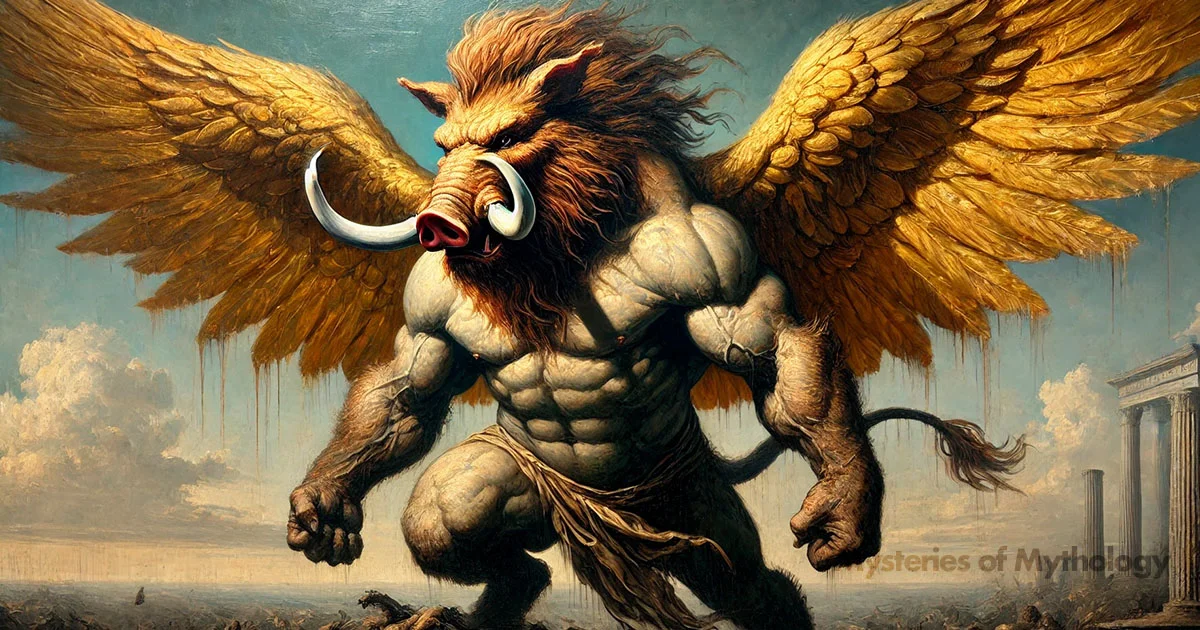
Afterwards, Perseus stored Medusa’s head in a magical satchel and used his winged sandals to escape the vengeful Gorgon sisters. Perseus began his journey back to Seriphos.
As he flew over Libya, a few drops of Medusa’s blood fell to the ground. Wherever the blood touched, it turned into snakes, which is why Libya is said to be teeming with serpents even today.
According to Ovid, the corals of the Red Sea came to be when Perseus laid Medusa’s head on some seaweed after rescuing Andromeda. The blood from Medusa’s head seeped into the seaweed, causing it to harden and transform into the beautiful coral.
After slaying Medusa, Perseus used her severed head as a formidable weapon, using its petrifying power to defeat numerous enemies. In Libya, he used the head to slay the sea monster Cetus and save Andromeda, who later became his wife. When Andromeda’s former fiancé, Phineus, attempted to attack Perseus, he, too, met his end by gazing upon Medusa’s head. Perseus then returned to Seriphos, where he confronted King Polydectes. Showing the king Medusa’s head, Perseus turned him to stone, protecting his mother from the king’s advances.
In some accounts, Perseus encountered the Titan Atlas during his travels. When a conflict arose between them, Perseus used Medusa’s head to turn Atlas into stone, so the mighty Titan became the Atlas Mountains. Eventually, he presented the head to Athena, who placed it on her shield, the Aegis, which continued to serve as a symbol of protection.
Worship
Medusa wasn’t worshipped in ancient Greece, but her image was frequently used as an apotropaic symbol, meaning it was believed to ward off evil. Her face, often depicted with wide eyes and snakes for hair, was carved into armour, shields, and even buildings to protect against evil forces.
Pop Culture
In cinema, Medusa is perhaps most famously depicted in the 1981 film Clash of the Titans, where Ray Harryhausen’s stop-motion animation brought the snake-haired Gorgon to life, making her an iconic figure in fantasy cinema. The 2010 remake of the film, played by Natalia Vodianova, reimagined Medusa with a more humanised face that contorts when she turns her victims to stone. In the same year, Uma Thurman played Medusa in Percy Jackson & the Olympians: The Lightning Thief.
In literature, Medusa has been reinterpreted in modern times, especially within feminist narratives. Books like Madeline Miller’s Circe humanise Medusa, exploring her story as a victim of the gods rather than a villain, reflecting broader societal shifts in how her myth is viewed. This perspective is echoed in feminist discussions and analyses, where Medusa often symbolises female rage and the reclaiming of power after trauma.
In video games, Medusa frequently appears as a formidable enemy or boss character, such as in God of War and Kid Icarus: Uprising, where she embodies the powerful, feared woman archetype. These portrayals often emphasise her monstrous qualities, though some modern games also touch on her tragic backstory, reflecting a more nuanced understanding of her character.
Medusa’s image has also been adopted in fashion and art, most notably by the luxury brand Versace, which uses her face as its logo, symbolising allure and danger.
Frequently Asked Questions
What is Medusa’s real story?
Medusa’s story varies across sources, but the most common version depicts her as a beautiful maiden who was transformed into a monster by the goddess Athena. This transformation occurred after Poseidon violated Medusa in Athena’s temple. In her monstrous form, Medusa had snakes for hair and a gaze that turned people to stone. She was eventually killed by the hero Perseus, who used her severed head as a weapon before giving it to Athena.
Why was Medusa so evil?
Medusa is often portrayed as “evil” due to her monstrous appearance and lethal gaze. However, many modern interpretations suggest that Medusa’s so-called evilness is a result of her transformation and the trauma she endured rather than an inherent trait. She was punished and turned into a monster by Athena, making her more of a tragic figure than a villain.
Is Medusa good or bad?
Medusa’s morality is complex and depends on the perspective. In traditional mythology, she is viewed as a terrifying monster. However, contemporary interpretations often depict her as a victim of circumstances beyond her control, highlighting the injustices she faced. As such, she can be seen as both a symbol of danger and a figure of tragic sympathy.
What is the sad story of Medusa?
The sad aspect of Medusa’s story lies in her transformation from a beautiful maiden into a feared monster. According to Ovid’s *Metamorphoses*, she was raped by Poseidon in Athena’s temple, and instead of punishing Poseidon, Athena cursed Medusa, turning her into a Gorgon. This curse made her a pariah, leading to her eventual death at the hands of Perseus.
Why is Medusa cursed?
Athena cursed Medusa after Poseidon violated her in the goddess’s temple. Enraged by the desecration of her sacred space, Athena transformed Medusa’s beautiful hair into snakes and gave her the ability to turn anyone who looked at her into stone. The curse was less a reflection of Medusa’s actions and more a punishment imposed by a powerful deity.
References
- Aeschylus, Prometheus Bound
- Apollonius of Rhodes: Argonautica
- Hesiod, Theogony
- Hyginus, Astronomica
- Homer, Iliad (The Shield with a Gorgon)
- Ovid, Metamorphoses
- Pindar, Pythian Ode

